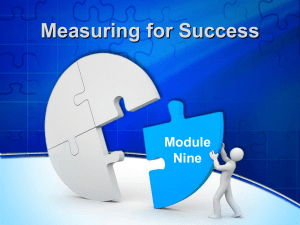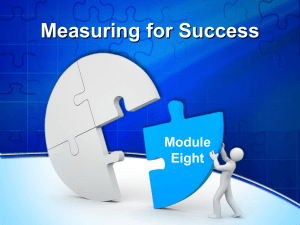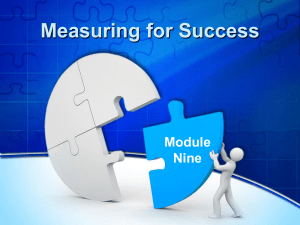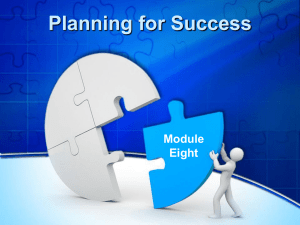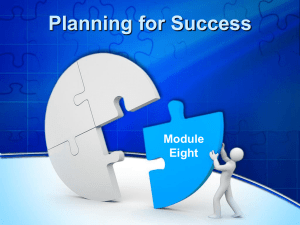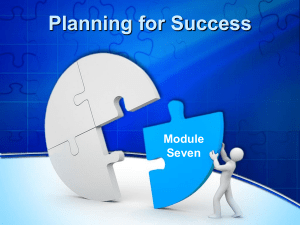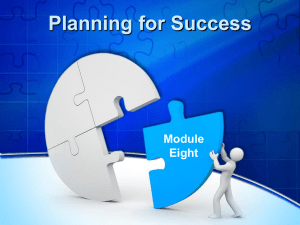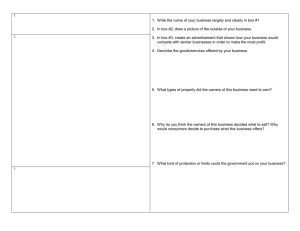Module Nine – PowerPoint Print Version
advertisement
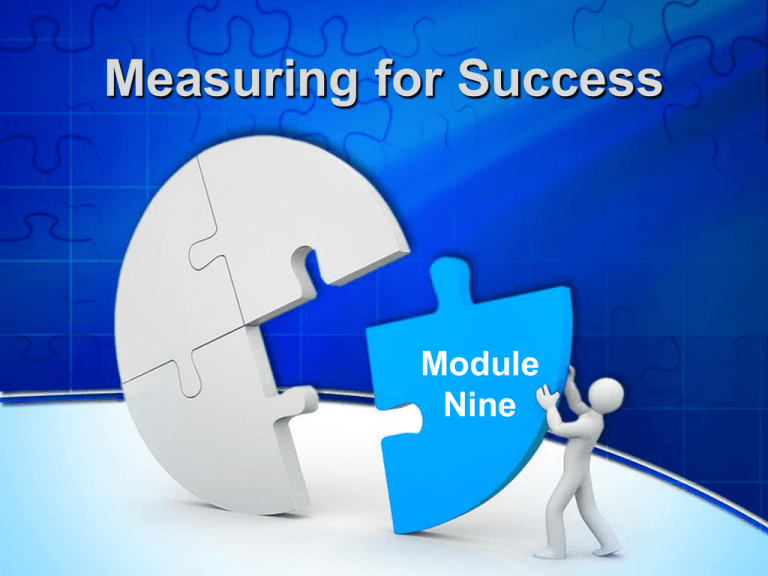
Measuring for Success Module Nine Reflecting on the Previous Session • What was most useful? • What progress have you made? • Any comments or questions? Session Overview • • • • • Exploring the Value of Measuring Deciding What to Measure Using Measures to Promote Success Tracking Appropriate Measures Creating a Regional Plan for Measuring Success Group Discussion What things do you monitor or measure as part of your organization? What are you seeking to learn from those measures? Measuring for Success Means . . . Thinking about: • Who will make changes • How people will do things differently • What outcomes or impacts you expect • Which key indicators can help determine progress DECIDING WHAT TO MEASURE Traditional Measures Measuring What We Do Versus Measuring the Difference We Make Strategies: What We Do My Organization Does Things # Workshops Conducted # Counseling Sessions # Tech Asst. Sessions # Materials Distributed To/for People # Clients Served # Stakeholder Groups # Partnerships Three Levels of Measuring Success Do You Know Your ABCs? Attitudes, Knowledge and Skills Short-Term Behavior Intermediate Real Impacts Conditions Long-Term Success USING ABCs TO PROMOTE SUCCESS Measuring ABCs: An Example Your team decides to focus on fostering small business growth by providing training on developing and managing Web-based sales. Strategy: Web Training for Small Business Owners Thriving Small Business Sector Measuring ABCs: An Example Problem: You have conducted the training for five years, but small business numbers are static or declining. Discussion: What are some possible points at which the strategy failed to produce the desired condition? Strategies: Part of the Story Counting what we did tells part of the story: • How many times did you offer the training? • How many small business owners attended? Measuring ABCs: Attitudes/Knowledge/Skills Strategy: Offered Web training for small business owners Participants scored poorly on post assessment Measuring Attitudes, Knowledge and Skills Course correction? Measures: Behavior Strategy: Offered Web training for small business owners Participants did not start Web sites Measuring Behavior Course correction? Measures: Condition Strategy: Offered Web training for small business owners Participants started Web sites but have seen no income or job growth Measuring Conditions Course correction? Points for Course Correction Web Training for Small Business Owners Number of Trainings & Participants Attitudes, Knowledge, and Skills Scores on Post Assessment Behavior Conditions Number of Websites Started Thriving Small Business Sector Number of New Websites Generating Income TRACKING APPROPRIATE MEASURES Key Questions in Developing a Plan • What information do we need? Does it already exist? OR Will you need to gather it? • Who has access to the information? • When should we gather? How often? • How can we gather the information? Quick Guides for Measuring We can’t measure everything! Some quick guides: • Be reasonable. • Be thoughtful. • Be realistic. • Be smart. Measuring Attitudes/Knowledge/Skills Common Methods Include: • Pre/post survey • Skill assessment/demonstration • Practical application exercise • Willingness to participate in follow-up activities • Others? Measuring Behavior Change Common Methods Include: • Logging behaviors • Monitoring completion of follow-up activities • Follow-up surveys • Observation • Other ideas? Measuring Condition Change Common Methods Include: • Secondary data • Follow-up: Survey Panel Cohort • Other ideas? CREATING A PLAN TO MEASURE FOR SUCCESS Measurement Plan Template What you want to measure Strategies: The Strategy The Participants Attitudes/Knowledge/ Skills you want to change Behavior you want to change Condition you want to change What information you need Who has the information How you will get the information How often/when you will get the information Measurement Plan Example Your Plan Using Handout Two: Draft a Measurement Plan for the ABCs you identified in Module Eight Measurement Plan Feedback • Any new strategies or steps identified? • Opportunities for course corrections? • How will this plan foster success? • Additional information needed? Measuring Assets How are we doing as a regional team? It’s not just about numbers! How We Do Our Work • • • • • • Meeting evaluations Reflection questions Quarterly evaluation meetings Focus groups Interviews Other methods? Your Team: Partnership Evaluation So far, what: • Was a peak experience? • Was the best meeting? • Was a low point? • Could make meetings even more successful? • Could the partnership do to become even stronger? Partnership Planning • What plans can we put in place to ensure the viability of this partnership? • What strategies will work best with this regional collaboration? Succession Plan Revisited • • • • Establish plan early Create job descriptions for key positions Communicate time commitment Ensure overall mission is clearly written Your Plan: Wrapping It Up • • • • • Number of course correcting points? Responsibilities assigned? Manageable package? “Fall through the cracks” gaps? Right mix of assets? Keeping Your Eyes on the Goal Did the strategies: • Move us closer to achieving our regional goals? • Make effective use of our regional assets, strengths and opportunities? • Generate additional problems? • Other thoughts? Next Steps • Technical assistance • Plan documentation Module Debriefing • What topics did you find most helpful? • What did you find confusing? • What do you hope to implement soon? • Other items? Post Assessment Please take a few minutes to help us Measure FOR Success by completing the post-assessments.
